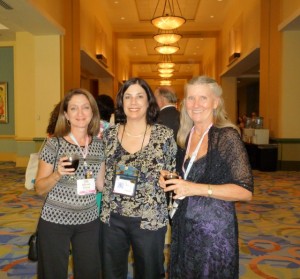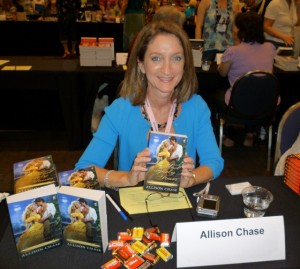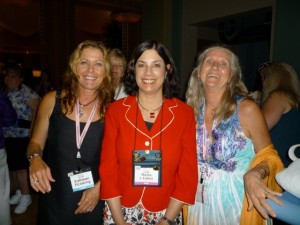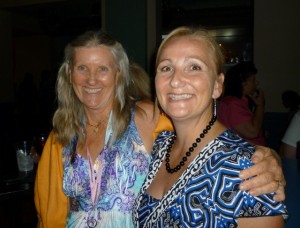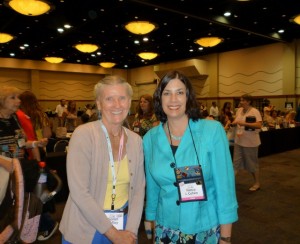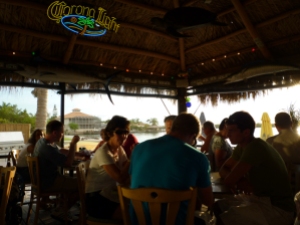RWA NATIONAL CONFERENCE, ORLANDO 2010
Thursday, July 29, 2010
The morning’s annual RWA meeting was followed by a keynote luncheon featuring NY Times bestselling author Nora Roberts aka J.D. Robb.
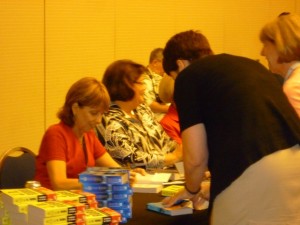
NORA ROBERTS Keynote Luncheon
Nora spoke about how technology changed from when she started writing in the days of typewriters. Writers used to go to the library for research, wrote letters by hand, and made phone calls on land line telephones. RWA started in Houston in the early 1980s, and Nora’s friends from those early days stayed with her throughout life. RWA provides networking and education and is a springboard for publishing.
Even though technology has changed, there are more opportunities in romance today. She talked about how we have to stay in the pool and avoid excuses like it’s too cold or we’re too tired or there are too many people crowding the water. Getting published is “supposed to be hard. Hard is what makes it special.” And regarding the value of RWA, “No one should have to face the hard alone.”

Publisher Lou Aronica’s State of the Industry Address at the PAN Retreat
“Slightly down is the new up” in this economy. Only a few bestselling titles sustain the publishing houses, according to veteran publisher Lou Aronica. Sales at the bottom of the list are low, as in dozens of copies sold. It’s very hard to sell a novel today even though many romance programs are fully sustainable. Sales at Amazon are up while Barnes & Noble sales are flat and Borders is having problems. Bookstores are in trouble like the CD music stores. Barnes & Noble realizes their brick-and-mortar stores are in jeopardy because consumers prefer to buy books online. Amazon buyers purchase books they are looking for in particular. The main problem there is that we cannot duplicate the bookstore browsing experience. There’s no place for impulse buyers. Amazon tries with their “if you like this book, then you’ll like…” but they mostly recommend bestsellers. Few readers are discovering new fiction online.
E-books are changing everything. Few people estimate the speed of change. It was predicted there would be 11 million ebook readers by the end of 2011 but we’ve already reached this level. 3 million iPads were sold by the end of last month. Before Kindle hit the market at the end of 2007, a few e-reader devices were available but not many people were interested. Now it’s a different story. But with soaring e-book sales, consumers don’t want to spend more than $12.99 on an e-book. This loss in sales revenue concerns publishers and bookstores. Barnes & Noble is making an effort by allowing consumers to read ebooks for free in their stores and to preview books they see on the shelves that way. Booksellers may promote the store as a social site for people to hang out, but if nobody buys print books from them, what then? CD stores went out of business because listeners wanted to buy online. Readers like the price and convenience of buying e-books online. It eliminates the need for manufacturing, distribution, and returns. This means a publisher could potentially make more money by selling an increased number of books for less. However, marketing is critical because the browsing experience is lost. Far more effort has to be put into marketing, plus ebook prices have to rise to return a profit.
Publishing to date has been a business-to-business industry. It goes from publisher to bookseller to consumer. Now, however, there is a business-to-consumer model, a demand market instead of an impulse market. New books go unsold because readers know what they want when they go online. Many publishers don’t have the staff, training, or interest in consumer marketing. So authors have to take charge of marketing their own work. As a writer, you need to find a community of readers specific to your book and market directly to them, but this requires time and money. Social media is a necessity. Book reviews used to drive sales and so did independent booksellers, but this is not the case anymore. Bloggers fill this void. Authors should reach out to bloggers who have a passion for reading. Again, this can be very time consuming.
If no one is printing or distributing the book, why do we need a publisher? Lou offers these reasons:
- Editorial input
- Advances
- Marketing
- Multimedia access
More niche publishers are yet to come with expertise in locating readers. Connecting to individual readers will rise in importance. Lou foresees a Renaissance and says it’s “a great age to be a writer.”

Writing in Multiple Subgenres: the Pros and Cons of Branching Out
Panel with authors ANN AGUIRRE, CYNTHIA EDEN, BETH KERY, ELISABETH NAUGHTON, JULIANA STONE, and BETH WILLIAMSON
I sat next to author LAURA BRADFORD who writes romance and mystery. It was nice to meet her. Panelist ANN AGUIRRE said she keeps her work fresh by writing in multiple genres. She takes a week off between books. She wanted to write a science fiction book women could enjoy and that inspired her popular Jax series. She would not want to settle down writing just one genre. CYNTHIA EDEN said she writes very fast and can do a draft in six weeks. The advantage of writing in multiple genres is you can produce as many books as you want although you may need a pseudonym. You can meet reader expectations in a new genre by writing with the same voice. “Don’t be afraid” to try a new genre. The cons of writing multiple genres are:
- Fans may not cross over if they’re dedicated genre readers.
- Multiple websites and promo may be necessary for pen names and this can get costly.
- Fans want you to stay in the genre they like.
- It can dilute your brand. You should be clear with your labeling on your website and other sites.
- Your publishers may expect you to write two or more books a year.
One author suggests doing double-sided promo items to separate the genres which can save you money. Connecting websites can be a way to attract crossover readers. But heed this caveat: “The only thing worse than not selling is overselling.” In other words, don’t overbook yourself when setting deadlines. Allow time for vacations, edits, page proofs, blog tours, etc. And just because Author X writes 10 pages a day doesn’t mean you have to produce the same. Everyone is different. Do what suits your lifestyle.
Paranormals
Panel with authors KELLEY ARMSTRONG, JEANIENE FROST, TERRI GAREY, COLLEEN GLEASON, JULIANA STONE, and CHERYL WILSON
The panelists discussed the differences between paranormal romance and urban fantasy. Paranormal romance has the happy ever after ending expected in the romance genre along with spin-off sequels, while urban fantasy employs first-person viewpoint and will have the same character recurrent in a series. However, these lines are blurring as some PNRs may have recurring heroines and some UFs may be less gritty. One author defined fantasy as more Tolkien in scope, while PNR involved “things that go bump in the night.” Whatever the subgenre, world building rules must be consistent. We may be seeing more stories based on mythology because this is still a “rich area to mine.”
The panelists spoke about their world building process. One author first defines her forces of conflict, i.e., good versus evil. Then she goes from the macro level down to the micro level starting with government and ending with daily life. What is unique about your world must be essential to your story. What does the culture value the most and what will they do to protect it?
Our last workshop on Thursday finished at 5:30. We headed off for drinks at the bar with our FRW pals: President KRISTIN WALLACE, KATHLEEN PICKERING, ONA BUSTOS, MICHAEL MEESKE, MONA RISK, CAROL STEPHENSON, DEBBIE ANDREWS, and more. Publicist JOAN SCHULHAFER stopped by to say hello. So did CFRW members DARA EDMONSON aka WYNTER DANIELS and CFRW prez LORENA STREETER. Then we all split to find dinner.
More workshop writeups coming over the weekend. Hit the Subscribe button if you want to stay informed about new posts.
Disclaimer: These workshop reports are based on my notes and are subject to my interpretation.
